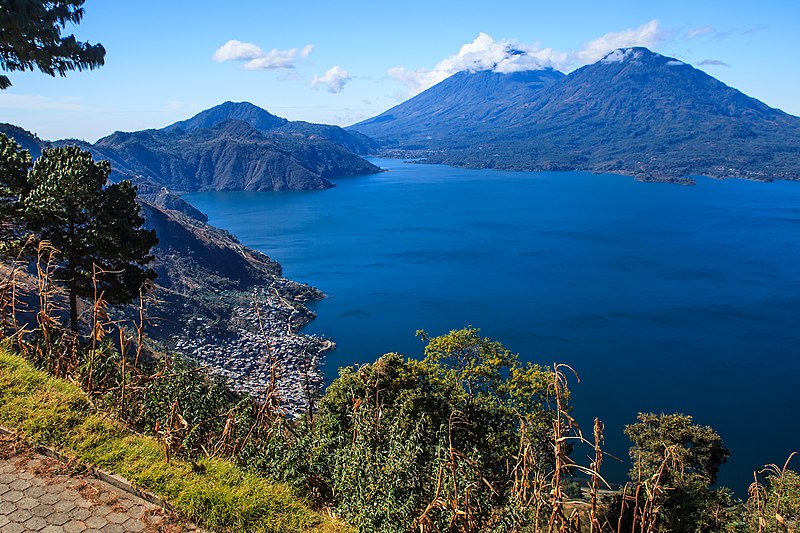
Lake Atitlan Facts
- This beautiful product of geological processes is mainly known to those who know of it by the name of Lake Atitlan. That’s the english language translation of its title, though. In the Spanish language, however, that translates to the term Lago de Atitlán.
- Both of these modern names derive quite closely from its original moniker. That sprang from the native tongue of the local Indigenous Peoples of its region. In the language of that People, the Nahuatl, the term approximately means “between the waters.”
- The awesome formation holds note for a variety of reasons. Among these remains the fact that it qualifies as the deepest lake in its part of the world. Yet this wonder of the natural world also ranks as the third largest by volume in that same region of the globe.
- This beautiful and distinctive lake also plays an important role in the culture of the area. In ancient times, it served as a prominent feature in the local Mayan culture. Amazingly, in many of the surrounding small villages, that culture remains prevalent.
- The stunning Lake Atitlan continues to be considered by many to be one of the most beautiful in the world. It thus naturally now serves as an important source of tourism in the area. It’s also become renowned as a location for cliff diving in recent decades.
Related Articles
Lake Atitlan Physical Description
Gorgeous Lake Atitlan certainly earns the appellation. Yet it also merits appreciation for more than just its beauty, though that’s present in great quantity. This holds true due to the fact that this body of water also boasts some highly respectable physical measurements.
It’s irregular in shape, of course, as most such formations are. Overall, however, it possesses a roughly rectangular structure. The visually pleasing lake measures roughly 11.2 mi (18 km) in length. The formation also has an approximate width of about 5 mi (8 km).
Combined, these two separate dimensions provide the geological marvel with a total surface area deserving respect. That aspect of the water body totals about 50.2 sq mi (130.1 sq km). This volume of water actually currently fills a gigantic ancient volcanic caldera!
It’s additionally quite deep in some parts of its area. The maximum known depth of the lake reaches down 1,120 ft (340 m). Overall, though, its waters maintain an average depth of 505 ft (154 m). This provides it with a total volume measuring 4.8 cubic mi (20 cubic km).
As if Lake Atitlan needed anything else to add to its impressive statistics, there’s more. It also sits surrounded by two separate distinctive geological features. These consist of a deep escarpment on one side, and on the other lies three equally impressive volcanoes.
Lake Atitlan Location, Formation, and Ecology
The magnificent Lake Atitlan formed in a region of the world renowned for its abundance of geological wonders. That general area of the globe won’t surprise many people. However, the precise section of that greater area might. It sits in what’s now the country of Guatemala.
More precisely, within the boundaries of that country in Central America, the lake’s situated in an isolated area. That’s the Guatemalan Highlands section of the Sierra Madre mountain range. That places this natural formation in the southwestern portion of the country.
Evidence places the first beginnings of its creation at about 11 million years ago. Research additionally indicates that since that time, at least four separate episodes of volcanic growth and caldera collapse have occurred. The latest happened about 1.8 million years ago.
The most recent known eruption took place 40,000 years ago. Subsequent to that latest activity, the lake itself formed over the last 10,000 years. It forms almost entirely from flows originating with two separate rivers. Rainfall also plays a smaller role in maintaining it.
The presence of Lake Atitlan serves to help maintain a thriving ecosystem surrounding it. An impressive total of 798 known species of flora appear around the site. That includes large forests of pine, oak, and conifers. Of these plants, a total of 61 evolved as endemic.
Given this, numerous species of animals also appear here. That includes 116 known amphibians and reptilians. At least 236 types of birds also live here, 28 % of which are Threatened. An impressive 141 mammalian species also make their home around the lake.
Features Sharing Its Region
Check out our other articles on 5 Marvelous Plants of Maine, Ribbon Seal, Cumberland Falls, European Honey Buzzard, Red Maple, Eastern Cicada Killer, Tiger Shark, Black Mamba
